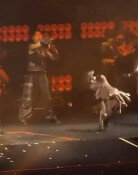Clothing that triggers sympathy
Clothing that triggers sympathy
Posted April. 02, 2012 05:58,
Five African Americans wearing horn-rimmed glasses appeared at a criminal court in Washington Tuesday. They were accused of shooting five people to death. A prosecutor asked one defendant who had confessed to his crime, Have the remaining four ever worn glasses before? The defendant said this was the first time that he had seen them wear glasses. The glasses the four wore were merely props with no prescription. Violent offenders often wear large-size suits and get their hair cut neatly to present themselves as nice and weak persons in court. A 2008 study by the U.S. Criminal Psychology Society showed that black suspects look more intelligent and less threatening" if they wear horn-rimmed glasses.
In the U.S., where jury trials are prevalent, the accused often wear clothes that trigger sympathy. A case in point is Valessa Robinson, a 17-year-old who colluded with her two boyfriends to murder her mother. Prosecutors spotted her as the main culprit, but her defense team disguised her as an innocent and pitiful girl who was deceived by her boyfriends. She appeared in the court wearing a white sweater, a brown pleated skirt and round shoes. She often brushed her hair off her shoulder to show her ear. Her grandmother said, My foul-mouthed granddaughter has become a different person. One of her two boyfriends was sentenced to death and the other got 25 years in prison, but the girl got just 13 years.
In 1997, Hanbo Group Chairman Chung Tae-soo appeared in a wheelchair before prosecutors. Since then, wheelchairs and patient gowns have become a sort of dress code for conglomerate heads when appearing before prosecutors. When summoned for questioning, Taekwang Group director Lee Seon-ae mobilized a camp bed in January. Con artist Shin Jeong-ah, who was convicted of academic fraud, appeared in court wearing horn-rimmed glasses and a gray shirt instead of her usual fancy clothing. By contrast, notorious criminal Shin Chang-won showed his anti-sociality by wearing a shirt with flashy patterns when he was arrested after years on the lam.
Judges have seen quite a few actors in court, including a CEO who intentionally takes out his dentures to mutter his final statement, a scammer who pretends to collapse and recovers consciousness when an ambulance arrives, and gangsters who lower their heads and exchange piercing eyes. Judges should not be deceived by clothing and performances by the accused.
City Desk Reporter Shin Gwang-yeong (neo@donga.com)






![“보풀 없애려다 ‘구멍’ 뻥”…옷 아래 ‘이것’ 깔고 깎아야 [알쓸톡]](https://dimg.donga.com/c/138/175/90/1/wps/NEWS/IMAGE/2025/12/16/132973814.3.png)
